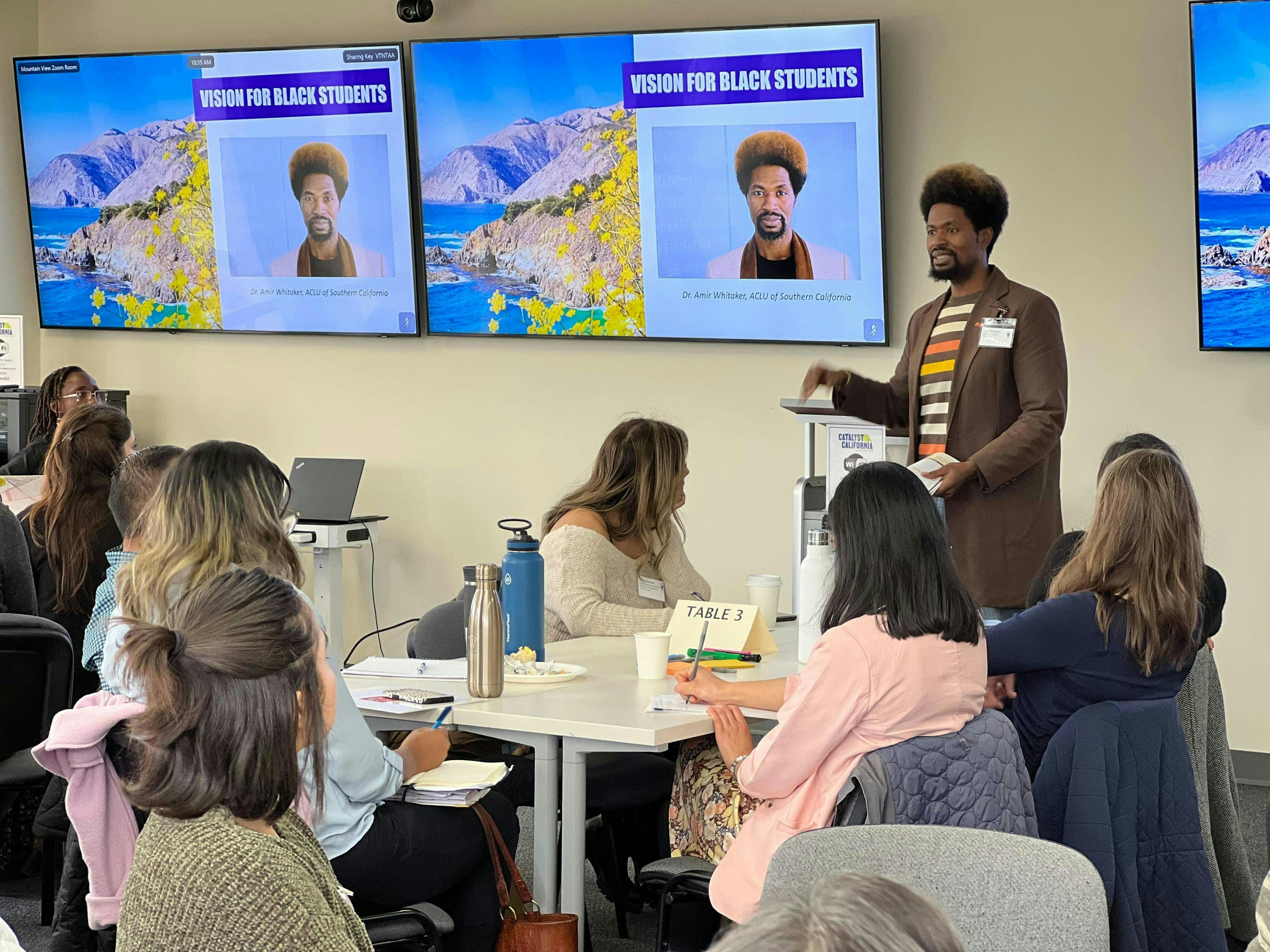Building a System Where Black Students and Families Thrive

By Day Son, Senior Manager of K-12 Policy
In this final post of our blog series featuring our March 2023 Water Cooler convening, “A 10-Year Milestone: Deepening Racial Equity in LCFF,” we conclude by looking towards the long-term horizon for equity—particularly for Black students, who continue to experience some of the greatest disparities in public education. Throughout the event, Black education leaders, parents, and grassroot organizations as well as equity champions from the Water Cooler Network shared the current reality facing Black students and families, what work is happening now, and what work must continue. The daylong discourse concluded with a conversation around the need to build a bold, long-term vision of what is critical to create a system in which Black students and families thrive. The discussion centered on the following themes found below.
Accountability, Transparency, Shared Power, and Decision-making
A central point echoed throughout the convening centered around the inextricable link between accountability and transparency and shared power and decision-making. Leaders shared how Black families and students are often excluded from the table during decision-making processes; hence, they stressed the importance of meaningfully including both groups. Although Black students, families, and community members offer a myriad of assets and expertise that can help foster student flourishing, they remain largely untapped. Leaders shared the following is needed for meaningful shared power and accountability for all education stakeholders, but particularly for Black communities:
- Extensive support for Black families and students to equitably participate (e.g., mental health resources, compensation, decision-making power)
- Transparent, accessible district and school-site data around academic and non-academic indicators (e.g., chronic absenteeism) to empower Black students, families, and community members to hold the district accountable and engage in decision-making
- Comprehensive information on how resources are being implemented to increase transparency and allow Black families to better monitor if and how their students’ needs are being met
- Participatory budgeting with students and families so they can co-determine with the district how resources are allocated to more effectively support Black students
Funding Structures and Investments
When it comes to funding, partners identified promising opportunities to ensure that funding structures and investments can equitably resource BIPOC students. Leaders named avenues such as using academic performance to help target LCFF funds for students—particularly for Black students, who are omitted from the targeted student population designation yet have faced steep opportunity gaps for generations. Some additional approaches include:
- Funding mechanisms like the Los Angeles Unified School District’s Student Equity Needs Index (SENI), which is an equity index that leverages academic, non-academic, and community indicators to understand students’ holistic needs and equitably distribute resources based on identified levels of student need at schools. Through this comprehensive approach, SENI helps address issues that disproportionately impact Black communities (as well as other communities of color and other historically underserved populations) yet may remain unaccounted for within the current LCFF structure.
- On a broader scale, funding structures that allow for participatory budgeting can promote accountability and effectiveness by shifting some of the budget decision-making power to students and families. Through this approach, Black communities can help determine how funds—including carryover—can be invested in ways that support Black students’ wellbeing and success.
Support and Continuous Learning
In order to fully live into the equity vision of LCFF, school systems require adequate support and continuous learning to buttress ongoing implementation. Leaders uplifted building staff capacity as a key example to help address this need. They cited the need for teacher and administrator preparation programs—along with districts and schools—to incorporate trainings on culturally engaging and sustaining curriculum and practices for Black students, as well as culturally responsive family engagement. High-quality instructors and leaders are critical for all schools, and providing access to expansive support both in staff’s preparation and ongoing development will strengthen districts’ abilities to be more responsive to the needs of its Black students, families, and communities.
Broader Vision of Systems-level Change
Lastly, partners resoundingly called for a broader vision of systems-level change that interrogates the racism still permeating public education today and transforms the system into one that honors the humanity and assets of all students, and particularly Black students. Examining how white supremacy historically and currently undergirds education can help us understand the depth and extent of racial disparities, as well as shed light on what is needed beyond surface reforms. Given the current limitations established by Prop 209, there is also a need to build the capacity and will for the public to ensure Black students are getting the support and resources they need to succeed. All of this can help pave the way for transformation coupled with narrative change that encompass schooling, curriculum, teacher education, and more to fully support Black students and families to thrive.
As historic as the LCFF policy was towards equity, educational equity champions from the Water Cooler Network are clear that more must be done together to move toward a racially just public education system in California. We must continue working together to transform our Birth to 12th Grade system to truly honor Black students and families as partners, fully invest in their holistic success, and dismantle the racist underpinnings that have existed for too many generations.
